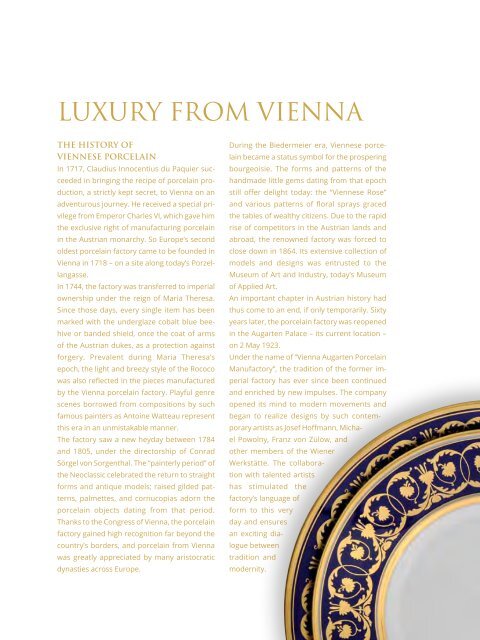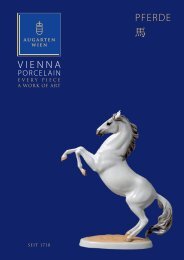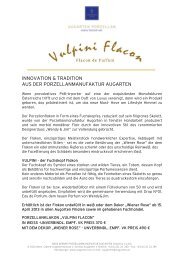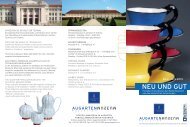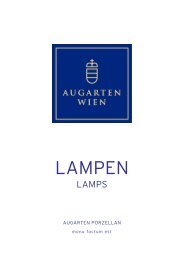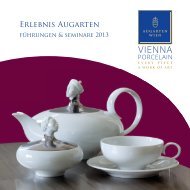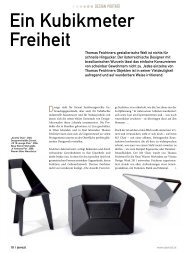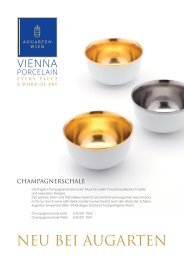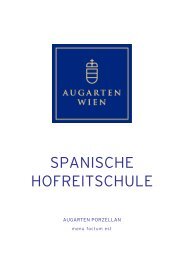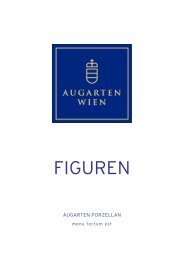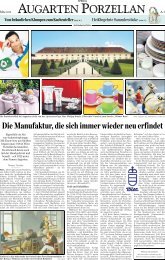Porcelain - Augarten Porzellan
Porcelain - Augarten Porzellan
Porcelain - Augarten Porzellan
Erfolgreiche ePaper selbst erstellen
Machen Sie aus Ihren PDF Publikationen ein blätterbares Flipbook mit unserer einzigartigen Google optimierten e-Paper Software.
luxury froM Vienna<br />
tHe HistoRy of<br />
Viennese PoRcelain<br />
In 1717, Claudius Innocentius du Paquier succeeded<br />
in bringing the recipe of porcelain production,<br />
a strictly kept secret, to Vienna on an<br />
adventurous journey. He received a special privilege<br />
from Emperor Charles VI, which gave him<br />
the exclusive right of manufacturing porcelain<br />
in the Austrian monarchy. So Europe’s second<br />
oldest porcelain factory came to be founded in<br />
Vienna in 1718 – on a site along today’s <strong>Porzellan</strong>gasse.<br />
In 1744, the factory was transferred to imperial<br />
ownership under the reign of Maria Theresa.<br />
Since those days, every single item has been<br />
marked with the underglaze cobalt blue beehive<br />
or banded shield, once the coat of arms<br />
of the Austrian dukes, as a protection against<br />
forgery. Prevalent during Maria Theresa’s<br />
epoch, the light and breezy style of the Rococo<br />
was also reflected in the pieces manufactured<br />
by the Vienna porcelain factory. Playful genre<br />
scenes borrowed from compositions by such<br />
famous painters as Antoine Watteau represent<br />
this era in an unmistakable manner.<br />
The factory saw a new heyday between 1784<br />
and 1805, under the directorship of Conrad<br />
Sörgel von Sorgenthal. The “painterly period” of<br />
the Neoclassic celebrated the return to straight<br />
forms and antique models; raised gilded patterns,<br />
palmettes, and cornucopias adorn the<br />
porcelain objects dating from that period.<br />
Thanks to the Congress of Vienna, the porcelain<br />
factory gained high recognition far beyond the<br />
country’s borders, and porcelain from Vienna<br />
was greatly appreciated by many aristocratic<br />
dynasties across Europe.<br />
During the Biedermeier era, Viennese porcelain<br />
became a status symbol for the prospering<br />
bourgeoisie. The forms and patterns of the<br />
handmade little gems dating from that epoch<br />
still offer delight today: the “Viennese Rose”<br />
and various patterns of floral sprays graced<br />
the tables of wealthy citizens. Due to the rapid<br />
rise of competitors in the Austrian lands and<br />
abroad, the renowned factory was forced to<br />
close down in 1864. Its extensive collection of<br />
models and designs was entrusted to the<br />
Museum of Art and Industry, today’s Museum<br />
of Applied Art.<br />
An important chapter in Austrian history had<br />
thus come to an end, if only temporarily. Sixty<br />
years later, the porcelain factory was reopened<br />
in the <strong>Augarten</strong> Palace – its current location –<br />
on 2 May 1923.<br />
Under the name of “Vienna <strong>Augarten</strong> <strong>Porcelain</strong><br />
Manufactory”, the tradition of the former imperial<br />
factory has ever since been continued<br />
and enriched by new impulses. The company<br />
opened its mind to modern movements and<br />
began to realize designs by such contemporary<br />
artists as Josef Hoffmann, Michael<br />
Powolny, Franz von Zülow, and<br />
other members of the Wiener<br />
Werkstätte. The collaboration<br />
with talented artists<br />
has stimulated the<br />
factory’s language of<br />
form to this very<br />
day and ensures<br />
an exciting dialogue<br />
between<br />
tradition and<br />
modernity.<br />
www.augarten.at 27


